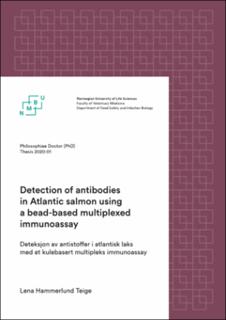| dc.contributor.advisor | Boysen, Preben | |
| dc.contributor.advisor | Dahle, Maria K. | |
| dc.contributor.advisor | Storset, Anne | |
| dc.contributor.author | Teige, Lena Hammerlund | |
| dc.date.accessioned | 2023-02-23T08:29:41Z | |
| dc.date.available | 2023-02-23T08:29:41Z | |
| dc.date.issued | 2020 | |
| dc.identifier.isbn | 978-82-575-1665-9 | |
| dc.identifier.issn | 1894-6402 | |
| dc.identifier.uri | https://hdl.handle.net/11250/3053470 | |
| dc.description.abstract | Viral diseases are among of the main challenges in aquaculture in Norway today. Heart- and skeletal muscle inflammation, caused by Piscine orthoreovirus (PRV), and pancreas disease (PD), caused by Salmonid alphavirus (SAV), both cause huge losses of farmed Atlantic salmon. Vaccination is a possible solution that is already contributing to the control of bacterial diseases. Unfortunately, making effective vaccines against viral diseases has been challenging and information about which immune mechanisms that are involved in protection is lacking.
Antibodies can mediate complete protection against some diseases, and antibody levels after vaccination can correlate with protection, even if the protection is mediated by other mechanisms. In addition, antibody detection can be used in disease surveillance to determine if a fish population is or has been infected with a virus. Unfortunately, measuring antibody levels in salmon is not straightforward. Such measurements have not been widely used, and often show high levels of background binding. An important reason for this is that fish antibodies are of the IgM type. IgM is less specific than IgG, the dominating antibody in mammals. Therefore, other methods, like PCR and histology, are more used in diagnostics in Atlantic salmon. In this work, we have for the first time used an assay based on microscopic magnetic beads conjugated with antigen to measure antibody levels in Atlantic salmon. This method has a high sensitivity and can be used to measure antibodies against several proteins simultaneously in the same sample.
By using this method, we have detected antibodies against PRV and SAV. In paper I and II, plasma from two PRV challenge trials was used to detect antibodies against the PRV proteins μ1c, μNS and σ1. We also detected antibodies against PRV1- σ1 in plasma from PRV-3-infected rainbow trout. There have been no previous publications detecting antibodies against PRV. The peak antibody level coincided with decreased pathology in the heart. In addition to showing virus-specific antibodies, our results show an increase in non-specific antibodies in PRV-infected salmon. This unspecific binding, but not the virus-specific binding, was decreased by heat treatment of samples. The nonspecific antibodies could be so-called polyreactive antibodies. Polyreactive antibodies could be crucial in protecting the salmon against infections before the adaptive immune system has had time to react, but their function, as well as the function of virus-specific antibodies during a PRV infection is unclear.
In paper III, we detected antibodies against whole SAV particles disrupted with Triton-X. The antibody binding increased from between week three and week six after the introduction of SAVinjected shedder fish. The SAV particles also worked well with little background binding when analyzing plasma from a PD outbreak in the field. Antibodies were detected in most fish from four weeks after the start of the outbreak, and the antibody level stayed elevated until the last sampling point at 15 weeks. At this time point, most samples were negative for virus when analyzed with RTqPCR, showing that serology has a longer window of detection compared to detection of viral RNA by RT-qPCR.
These results show that both virus-specific and non-specific antibodies can be produced after infection in Atlantic salmon. The method used is well suited for antibody detection in salmon but can be complicated by the presence of non-specific antibodies. It is therefore crucial to optimize the antigens for detection of specific antibodies. | en_US |
| dc.description.abstract | Virussykdommer er en av de store utfordringene i oppdrettsnæringa i Norge i dag. Hjerte- og skjelettmuskelbetennelse, forårsaket av Piscine orthoreovirus (PRV), og pankreas sykdom (PD), forårsaket av Salmonid alphavirus (SAV), fører begge til store tap av atlantisk laks i oppdrett. Vaksinering er en mulig løsning som allerede har bidratt til god kontroll på bakterielle infeksjoner hos laks. Dessverre er det utfordrende å lage vaksiner som virker godt mot virusinfeksjoner. Informasjon om hvilke immunfunksjoner som er involvert i beskyttelse er også mangelfull.
Antistoffer kan gi full beskyttelse mot noen sykdommer, og antistoffnivået etter vaksinering kan korrelere med beskyttelsen, også om beskyttelsen skyldes andre immunmekanismer. I tillegg kan antistoffdeteksjon brukes i sykdomsovervåkning for å finne ut om fiskepopulasjoner er eller har vært infisert med et virus. Dessverre er det ikke rett fram å måle antistoffnivå hos laks. Antistoffmåling er lite brukt og det er ofte mye bakgrunnsbinding. En viktig grunn til dette er at fiskens antistoff er av typen IgM, som er mindre spesifikk enn IgG i pattedyr. Derfor er andre metoder, som PCR og histologi, mest brukt til påvisning av virussykdom hos laks. I dette arbeidet har vi for første gang brukt et assay basert på mikroskopiske magnetiske kuler konjugert med antigen til å måle antistoffnivå i laks. Denne metoden har høy sensitivitet og gir muligheten til å måle antistoffer mot mange proteiner i samme prøve samtidig. | en_US |
| dc.language.iso | eng | en_US |
| dc.publisher | Norwegian University of Life Sciences, Ås | en_US |
| dc.relation.ispartofseries | PhD Thesis;2020:01 | |
| dc.rights | Attribution-NonCommercial-NoDerivatives 4.0 Internasjonal | * |
| dc.rights.uri | http://creativecommons.org/licenses/by-nc-nd/4.0/deed.no | * |
| dc.subject | Atlantic salmon | en_US |
| dc.subject | Piscine orthoreovirus | en_US |
| dc.subject | Salmonid alphavirus | en_US |
| dc.subject | IgM | en_US |
| dc.subject | Immunoassay | en_US |
| dc.subject | Antibody | en_US |
| dc.title | Detection of antibodies in Atlantic salmon using a bead-based multiplexed immunoassay | en_US |
| dc.title.alternative | Deteksjon av antistoffer i atlantisk laks med et kulebasert multipleks immunoassay | en_US |
| dc.type | Doctoral thesis | en_US |
| dc.relation.project | Norges forskningsråd: 237315/E40 ViVaFish ; 280847/E40 ViVaAct | en_US |

